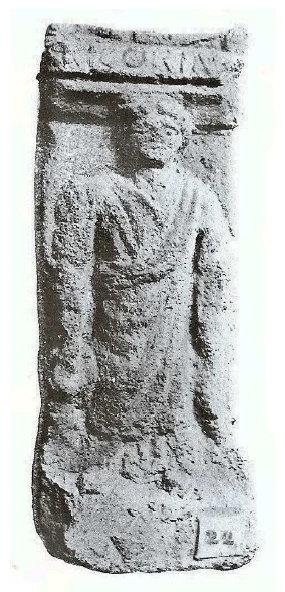e) [T]ricoria/Ricoria (‘Great Warrioress’ or ‘Liberating Queen’?)
The goddess Ricoria or Tricoria is known from a unique altar combining a figuration of the goddess with an inscription identifying her (fig. 40).1632 It was discovered in Béziers (Hérault), in the territory of the Volcae Arecomici, during excavations carried out on the ‘Plateau des Poètes’.1633 On the main panel, the name Ricoria is engraved above the rough representation of a draped goddess holding a patera* in her right hand and an undetermined object in her left hand. On the left side of the altar is inscribed the name of the dedicator C(aius) Pequ(ius) Catli(nus), who bears the tria nomina of Roman citizens. The votive formula v(otum) s(olvit) l(ibens) m(erito), which indicates that C. Pequius Caltus thanked the goddess for accomplishing a vow he had previously made, follows. The complete inscription is the following: [T]ricoriae/Ricoriae, C(aius) Pequ(ius) Catli(nus) v(otum) s(olutum) l(ibens) m(erito), ‘To [T]ricoria/Ricoriae, Caius Pequvius Catlinus paid his vow willingly and deservedly’. Finally, a patera* and a guttus* with handles are engraved on the right side of the altar. These two objects are common attributes of fertility characterizing land-mother goddesses.
The nature of this goddess is problematic, for scholars do not agree on the spelling and meaning of her name. Moreover, her figuration being that of an ordinary goddess of fertility, it is difficult to determine which specific functions she may have fulfilled. Some specialists propose to read her name as [T]ricoria, inducing that she was the tribal-goddess of the Tricorii (‘the Three Troops’ or ‘The Triple Armies’), a tribe neighbouring the Vocontii, in the south east of Gaul.1634 The altar was not discovered in their territory, but not very far away, and accordingly this theory remains plausible. The divine name Tricoria would thus be composed of the Celtic terms tri- meaning ‘three’ and corio- signifying ‘troop’ or ‘army’, cognate with Old Irish cuire, ‘troop, army’, Welsh cordd, ‘tribe, clan, troop’, Middle Breton cost-cor, ‘family, troop’, derived from IE *korios, *koros signifying ‘people in arms’.1635 This root, which undeniably denotes war, occurs in other names of septs*, such as the Coriosolitae (‘Army of the Solitae’ or ‘Complete Army’?) situated in the present-day Côte d’Armor, the Uocorii (‘the Two Troops’), the location of which is unknown, the Vertamocorii, inhabiting the present-day Vercors and the Petrocorii(‘the Four-Troops’), located between the River Dordogne and the River Vézère (Corrèze).1636 Interestingly, Elmer Antonsen explains that the proper names Corius, Coria, Coriso are equivalent to Runic* Hariso which signifies ‘female warrior’.1637 Tricoria could therefore be the goddess of the ‘Triple Army’ or ‘the Triple Female Warrior’. On account of her portrayal and the etymology* of her name, it can be inferred that Tricoria combines attributes of fertility and war. She may have simultaneously been the embodiment of the land, providing her people with fertility, and the patroness of the Tricorii and their territory.
And yet, the reconstitution of her name as Tricoria remains highly unlikely. When looking more closely at the altar, it can be noticed that there is no place for a supplementary letter.1638 Therefore, the goddess name is very certainly Ricoria.1639 Contrary to whatAllmer asserted at the end of the 19th c., Ricoria is not a Latin name, but clearly a Celtic name.1640 One possibility would be to analyse Ricoria as *Re-coria < Ro-coriā, with an intensive particle re/ro meaning ‘very’, ‘great’ and the root coria, ‘troop’, ‘army’ and possibly ‘female warrior’. Ricoria is thus the ‘Great Army’ and maybe the ‘Great Female Warrior’.1641 Alternatively, her name could be broken down as *Rīgo-riā, with rīgo, ‘king’, ‘queen’ and possibly ria, ‘free’.1642 Accordingly, Ricoria may be glossed as ‘Free Queen’, with the meaning of being a ‘liberator’.
In view of those two plausible etymologies, it can be induced that Ricoria possesses pronounced sovereign, protective and war aspects. Was she a warrioress or a divine queen fighting for the liberty and well-being of her people? Her very ordinary iconography, which denotes her powers of fertility and benevolence, does not shed any light on that question. As for Vaillat’s theory that she may have been a water-goddess associated with a local spring, there is no etymological or archaeological proof indicating such a possibility.1643
